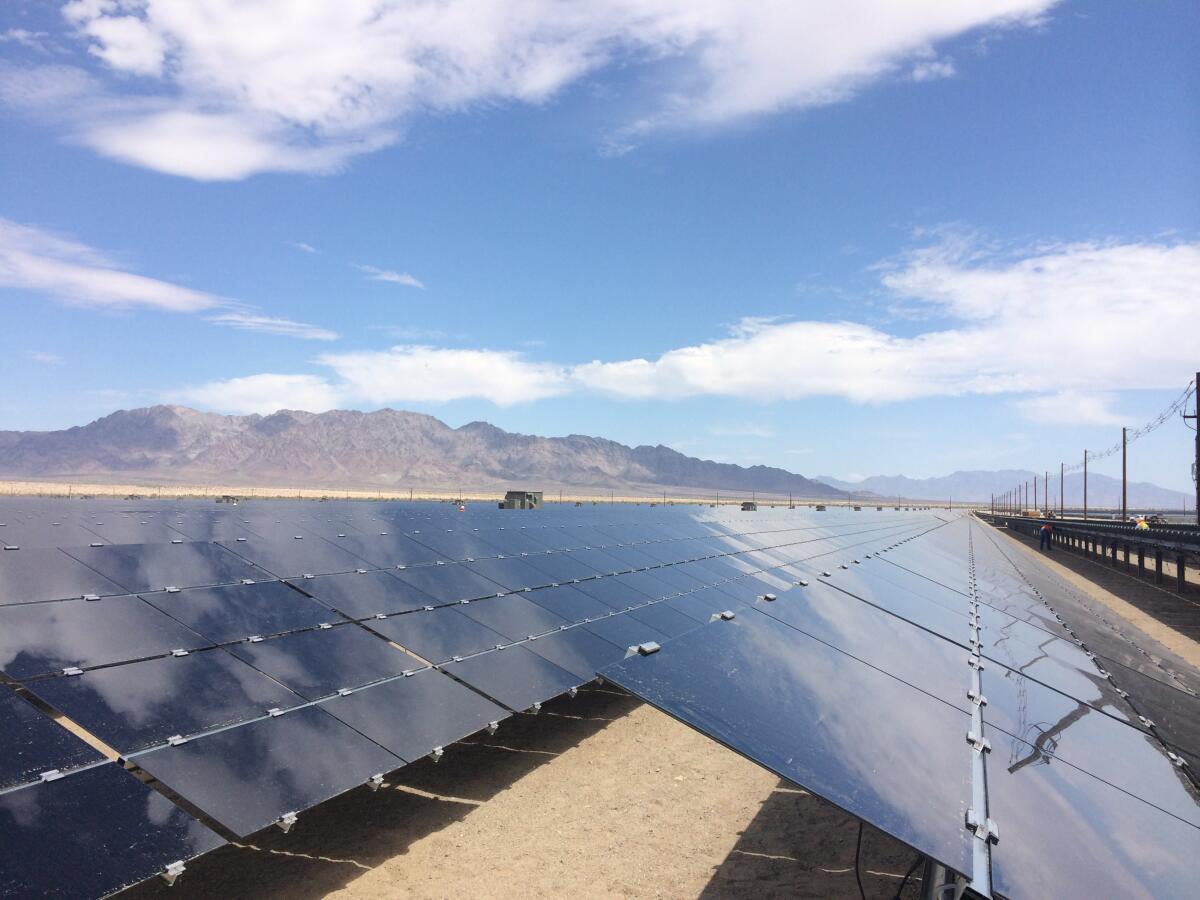The Inflation Reduction Act is now law. What it will do for Californians

- Share via
After more than a year of negotiations among Democrats, President Biden finally signed a major climate change, energy and healthcare bill into law Tuesday.
Now that the approximately $700-billion package is in the books, what will it mean for you? Here’s a look at how the bill’s provisions could impact Californians.
Healthcare
California stands to gain the most from several of the bill’s healthcare provisions because it has the largest number of potential beneficiaries.
For starters, the bill would continue for three years the extra premium subsidies for Affordable Care Act insurance policies that last year’s American Rescue Plan inaugurated. Those subsidies — which amounted to $1.7 billion a year for California alone — dramatically lowered premiums for more than 1 million Californians, including middle-income consumers who had not been eligible for aid previously. Under the act, no one shopping for an Obamacare plan would have to pay more than 8.5% of their income in premiums.
Covered California, the state’s health insurance marketplace, estimated that 220,000 Californians would no longer have been able to afford insurance if the extra subsidies were discontinued. Rates for many lower-income Californians would have doubled, with premiums going up 71% on average for those earning less than 400% of the poverty line, Covered California estimated.
Now, with the aid extended and the state contributing its own subsidy dollars, many Californians could face even lower barriers to obtaining healthcare. Anthony Wright, executive director of the advocacy group Health Access California, said Covered California could conceivably offer low- and moderate-income consumers a comprehensive, mid-tier policy with no deductible, potentially saving them hundreds to thousands of dollars.
“So we go from the worst of times (the doubling of premiums) to the best of times (capped premiums, and reduced cost-sharing, including in many cases deductibles eliminated). That adds real affordability for California consumers,” Wright said in an email.
The Inflation Reduction Act to cap drugmakers’ price hikes, tax wealthy corporations and reduce emissions by 2030 goes to Biden for his signature.
California also has more Medicare beneficiaries — 6.6 million in July — than any other state, so the changes in that program will have the most effect in this state. Those changes will help lower seniors’ drug costs, limit increases in Medicare Part D premiums and provide more help to lower-income Americans.
Specifically, the act will benefit Medicare enrollees by:
Capping the price of insulin at $35 a month. Insulin prices have skyrocketed, rising more than four times faster than the pace of inflation from 2000 to 2018 before flattening during the pandemic. Almost half of U.S. states impose a cap of some kind already, but California, with the country’s largest population of people with diabetes (about 3.2 million), does not.
Putting a $2,000 annual limit on out-of-pocket costs for prescription drugs for enrollees in Medicare Part D, starting in 2025. According to the Kaiser Family Foundation, almost 115,000 Californians in Medicare Part D spent more than $2,000 out of pocket on drugs in 2020.
Providing vaccines at no cost. Previously, some adult vaccines (such as the one for shingles) required a copayment in Medicare. The change could save money for more than 460,000 Californians, the Kaiser Family Foundation estimated.
Limiting premium increases in Medicare Part D to 6% per year from 2024 to 2029. The act also repeals a Trump administration rule that was expected to raise Part D premiums by changing how insurers negotiated discounts with drug manufacturers.
Making more lower-income people eligible for Medicare Part D with deep discounts, starting in 2024. The act makes anyone earning up to 150% of the federal poverty level eligible for the discounted premiums and drug prices; the current limit is 135%. That could help more than 24,000 Californians, KFF estimated.
More broadly, the act calls on Medicare to negotiate lower drug prices each year from 2026 to 2029 for 10 to 20 of the costliest medications that face no effective competitors. Although the direct result would be savings for Medicare and its beneficiaries, the lower prices for those drugs could ripple through the market if private insurers use Medicare prices as a benchmark for their negotiations with drugmakers.
It also requires drugmakers to pay rebates to Medicare if they raise the price of drugs prescribed through Part B (typically chemotherapy drugs and other medications administered in a doctor’s office) more than the rate of inflation, starting in 2023. That change is projected to save the government more than $100 billion, but it’s not clear what effect it would have on Medicare beneficiaries and other American consumers.
Democrats hope the Inflation Reduction Act will be a new calling card for young voters in the midterm elections.
Energy and climate
The White House says the bill will reduce energy costs and greenhouse gas emissions. The nonprofit think tank Resources for the Future estimates families will save approximately $170 to $220 annually under the Inflation Reduction Act and that the bill will reduce electricity price volatility. But how?
Big picture, it’s a lot of tax credits, rebates and other financial incentives for both the people who make things like electric cars, rooftop solar panels and wind turbines, and for the people who buy them. Long-term, decreasing the costs to get more people to use renewable energy technology to power their homes and commutes is expected to reduce both greenhouse gas emissions and your bills. If power comes from renewable resources like the sun and wind harnessed at facilities in the U.S., it is less likely that something like, say, a war on a different continent could abruptly cause energy or gas prices to skyrocket.
In other words: A lot of these things will not directly lower your bills in the immediate future. But many are likely to create long-term cost savings on energy bills and transportation, as well as a positive effect on addressing climate change.
An analysis of the bill from Senate Democrats says the bill will help the United States lower greenhouse gas emissions by about 40% by 2030. It is challenging to precisely estimate how much your household might save by getting to continue living on this planet, but moving into a biodome or to Mars sounds costly.
Some of the highlights:
Tax incentives for buying electric or hybrid cars. The bill includes tax credits worth up to $7,500 for new electric and hybrid cars and up to $4,000 for used ones. To be eligible, the buyer, the vehicle and seller will have to meet certain requirements, like the buyer’s income, the price of the car, and the source of the materials used to make the vehicle.
Home energy rebate programs, grants and tax credits. Making your house more energy-efficient and less reliant on nonrenewable energy sources should cost less after this bill takes effect. Swapping out your old water heater, heat pump or HVAC system or adding solar panels could make you eligible for some money back in your pocket in the form of rebates or tax credits.
More money for manufacturing clean energy components and nuclear and renewable power production. There will be new, expanded or extended tax credits and additional sources of funding for things like manufacturing wind turbines and solar panels, and for producing power from nuclear and renewable sources. (The Bipartisan Policy Center has a more granular analysis of these programs.)
Infrastructure investments. The bill allocates funding for investments in low-carbon building materials for federal projects and in Department of Energy National Laboratories infrastructure. There’s also funding for forest management and reducing wildfire risks.
Last-minute tweaks to Democrats’ healthcare and climate bill added $4 billion to address the drought and water crisis along the Colorado River.
Taxes
There are no California-specific tax provisions in the Inflation Reduction Act, but some of the increases would fall heavily on the state’s tech giants.
The most significant is a new, 15% minimum tax on corporations that report at least $1 billion in profits over the previous three years. The provision targets a relatively small number of major companies that paid far less than the typical U.S. corporation, such as the 55 that paid no corporate income tax in 2020, according to the Institute for Taxation and Economic Policy.
Bloomberg reported that Facebook and Apple each paid less than 15% of their reported profits in taxes in 2020. It also cited a Bloomberg Intelligence analyst’s finding that 29 of the 60 top information tech companies in the S&P 500 paid less than 15% last year.
The actual effects of the tax, however, will depend in part on how businesses respond to the new rules. The Tax Foundation, a right-leaning think tank that criticized the tax, said the real estate and logistics industries — both major players in California — could see some of the biggest tax increases.
Another new tax soon to be felt by California businesses is a 1% excise tax on stock buybacks, which surged after President Trump signed the Tax Cuts and Jobs Act in 2017. California-based tech companies, such as Apple, Alphabet (Google and YouTube’s parent), Meta (Facebook) and Oracle, have spent hundreds of billions of dollars buying back stock in recent years in an effort to boost share prices.
One provision Republicans have cited repeatedly is an $80-billion expansion in the IRS’ budget, which could help close the gap between what taxpayers owe and what they actually pay. In response to the GOP critiques, Treasury Secretary Janet Yellen issued a letter to IRS Commissioner Charles P. Rettig directing that none of the new resources or hires be used to increase the chances that small businesses or households earning less than $400,000 will be audited.
A compromise package of inflation-fighting healthcare, climate change and deficit reduction strategies appears headed toward quick votes in Congress.
- Share via
Watch L.A. Times Today at 7 p.m. on Spectrum News 1 on Channel 1 or live stream on the Spectrum News App. Palos Verdes Peninsula and Orange County viewers can watch on Cox Systems on channel 99.
More to Read
Sign up for Essential California
The most important California stories and recommendations in your inbox every morning.
You may occasionally receive promotional content from the Los Angeles Times.

















